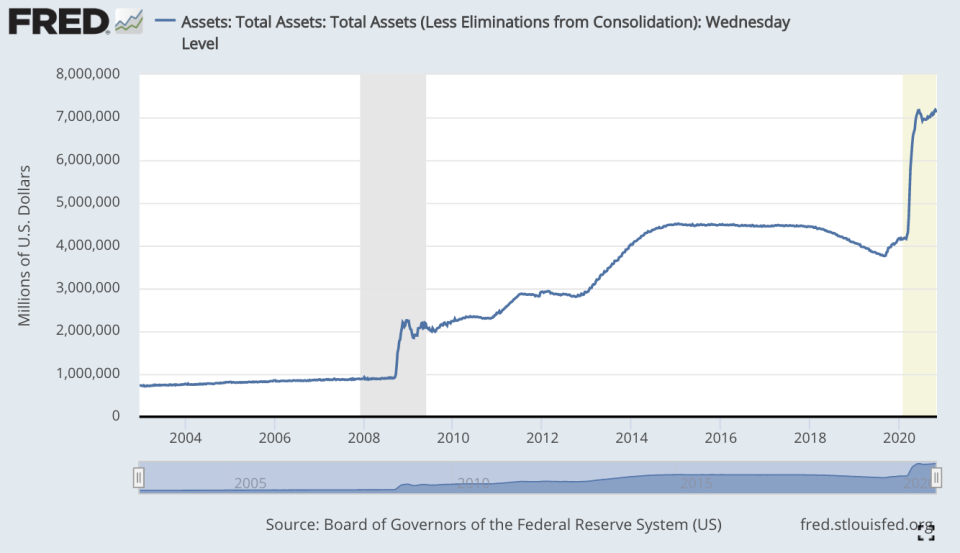Powell: Fed not 'out of ammo' to boost COVID-19 hit economy, can expand balance sheet, liquidity
Federal Reserve Chairman Jay Powell said Thursday that the central bank has several tools it could use to continue providing accommodation if the U.S. economic recovery lags — including an expansion of quantitative easing and an extension of its various liquidity facilities.
“Is monetary policy out of power or out of ammo? The answer to that would be ‘no,’” Powell told reporters following the Federal Open Market Committee’s decision to hold rates at near-zero.
Powell and his colleagues on the FOMC discussed the matter of its asset purchases, which to date have ballooned the Fed’s balance sheet to over $7 trillion. Since the summer, the Fed has been adding about $120 billion a month in U.S. Treasuries and agency mortgage-backed securities.

The Fed chair said Thursday that policymakers “like the accommodation the program is delivering” at the moment. But Powell said the FOMC could change the “composition, duration, size, life cycle” of its vast bond purchases, if needed.
Fed officials have hinted at the possibility of either increasing that $120 billion-per-month pace or targeting its purchases toward longer-dated securities. In the latter policy approach, the Fed could lower longer-term interest rates by skewing its purchases toward U.S. Treasuries with 10-year or longer maturities.
“All of those things are available to us as ways to deliver more accommodation if we think that’s appropriate,” the Fed chief said.
Powell said a rise in COVID-19 cases was “particularly concerning,” as the U.S. hit a new daily record of over 100,000 cases reported on Thursday. The Fed Chair opened his press conference by acknowledging that re-opening had led to a “rapid rebound of activity,” but warned that economic data since the summer have shown the recovery losing momentum.
What happens after December 31
Although quantitative easing will be a ready tool for the Fed to use over coming months, questions continue to swirl over the availability of the various liquidity facilities that the central bank has opened up since the pandemic began.
But 12 of the Fed’s liquidity facilities, including backstops to the municipal and corporate bond markets, are set to expire on December 31, after which the Fed would not be allowed to offer any new loans.
That would also include the Main Street Lending Program, the Fed’s effort to offer loans to small- and mid-sized companies. The central bank recently lowered the minimum loan size available under the program, to $100,000. However, if the Fed does not extend the deadline, businesses will have less than two months to access the credit.
One challenge is the Fed facilities were stood up by money appropriated through the Coronavirus Aid, Relief, and Economic Security (CARES) Act, which requires the U.S. Treasury to sign off on changes to how the Fed uses that money.
“We really are just turning to this issue now and we have not made any decisions,” Powell said Thursday, adding that that would be a decision made “jointly” with the Treasury.
But Powell added later that if economic conditions “deteriorate,” the Fed would want to extend its facilities, or even open new facilities.
With changes to the facilities and quantitative easing possibly on the way, the Fed’s next meeting on December 15 and 16 could be a substantial one.
Powell also said changes to its economic projections would also begin in that final meeting of 2020, which will now include two new graphs in addition to details on the FOMC members’ assessments of uncertainty and risk.
Brian Cheung is a reporter covering the Fed, economics, and banking for Yahoo Finance. You can follow him on Twitter @bcheungz.
Fed holds rates at zero amid 'considerable risks,' as economy 'continued to recover'
Fed lowers minimum loan size on small business loans to Main Street
Former NY Fed President: No conflict of interest between Fed and Congress
Less-educated Asian Americans among hardest hit by job losses during pandemic
A glossary of the Federal Reserve's full arsenal of 'bazookas'
Read the latest financial and business news from Yahoo Finance
Follow Yahoo Finance on Twitter, Facebook, Instagram, Flipboard, SmartNews, LinkedIn, YouTube, and reddit.

